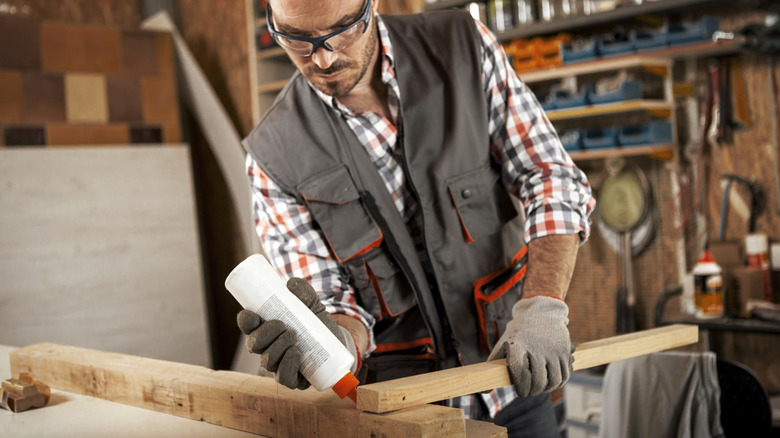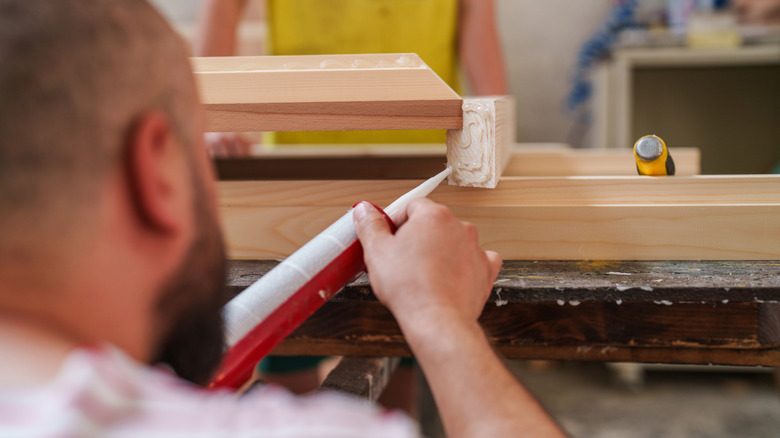Mistakes Everyone Makes When Using Wood Glue
It can be extremely frustrating when you're in the middle of a DIY project, and for some reason, your supplies just aren't working for you. It becomes all the more irritating when the project involves some sticky business. While it's easy to blame your materials and to think you have a faulty product, you may be simply making a mistake during execution. Wood glue, if you know when and how to use it for the best results, is a fantastic adhesive. Unfortunately, it's also one of the most popular DIY materials that many people seem to make mistakes with.
Wood glue is an adhesive material that helps secure wooden pieces together, and it's known for being an incredibly strong binding agent that can affix joints to withstand significant amounts of weight. But with this reputation, and likely a lack of knowledge regarding the different kinds of wood glue available, sometimes users don't utilize the material in a way that allows it to perform optimally. Common errors in applying wood glue are similar to the mistakes everyone makes when using Gorilla Glue around the house. Using the wrong sort of adhesive, applying the glue in ineffective ways, or using poorly prepared surfaces can cause wood glue to fail. Don't be caught off guard (or caught with a collapsed table) by these common mistakes everyone makes when using wood glue, and instead utilize these tips to avoid any problems.
The kind of glue you use matters
It's hard to admit sometimes, but understanding that you might be making some common mistakes with your DIY supplies may save you from cycling through a number of materials. When it comes to wood glue, there are a handful of very common mistakes. The first mistake has to do with the kind of wood glue you're using. Some glue materials work better on different woods and surfaces than others. For instance, most projects that necessitate wood glue can be completed using polyvinyl acetate glue, a water-based adhesive that dries down clear. It works well on breathable and porous wood materials, engineered woods, and medium-density fiberboard (MDF). However, for denser woods or antique pieces that necessitate even more strength than your regular wood glue, opt for hide glue, a stronger adhesive derived from animal products.
PVA glue is a great universal option, but you may find that it swells too much, which could get in the way of proper object assembly (i.e., your clamps aren't holding pieces together, or you feel like you need to take a hammer to encourage the pieces to fit). Hide glue performs well without swelling, so for joints that necessitate precision or experience lots of stress, like in musical instruments, hide glue is an optimal choice. Perhaps your wood glue isn't working out for you because your PVA glue is either not strong enough for the project at hand or is actually even interfering with the joint itself. Whichever glue you choose, allow it ample cure time before applying stress on it.
Why prep work and environment matters with glue
Another common mistake is not prepping your wood surfaces properly for application. Any residue on your wood, including dirt, grime, or sawdust, can get in the way of proper adhesion. Once everything is adequately prepped and you are at the stage to apply the glue, watch out for the quantity of glue you're using as well. If you use too little, you run the risk of improper binding, and the joint can therefore fail. However, using too much glue could also mean a headache for you down the line, as any excess glue that seeps out of the joint won't take any wood stain you apply. Therefore, remember to wipe away any extra glue before it dries down.
Lastly, remember that you should never use wood glue in the cold. Lower temperatures prohibit the glue's chemical binding reaction, and the result is a goopy, maple syrup-like mess that doesn't make for a very strong joint. The material becomes brittle if it manages to dry down, therefore compromising the integrity of the joint itself. In other instances, the glue just won't bind to begin with. Ensuring the quality of your supplies is always essential during a DIY, and using a product outside of its optimal environmental zones won't allow it to succeed. This rings true with the product's expiration date as well. If your glue is too old or has not been stored properly, that also compromises the quality. However, if you are mindful of your prep work, which glue you're using, and the environment in which you work, then your wood glue woes should subside.


